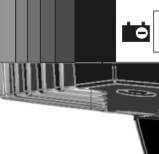It is the source – or sources – which sizes the choice of the battery isolator
I.e. RCE/100-1E-2IG model is designed for an input of 100A max.
The role of the isolator is to isolate the batteries between them and to distribute the available charging current.
The charge regulation will be ensured by the alternator (regulator) and the prioritization will be done automatically according to the state of charge of the batteries.
The nominal current of the isolator is understood on the basis of a distribution over 2 or 3 outputs depending on the model.
In the event that this nominal current is always constant on a single output (i.e. Lithium battery), an oversizing of the distributor model may be considered (consult us).
We recommend installing the battery isolator vertically as close as possible to the batteries.
The power supply must be switched off during installation.
The input terminal must be connected to the output of the alternator or the DC source concerned (solar panels, wind turbines, chargers).
The output terminals must be connected to the positive of the battery banks.
The negative of the isolator must be connected to the common negative of the batteries (on FASTON terminal – use a 0.5mm² cable – note: if this terminal is not connected, there is a major risk of destruction of the distributor).

(Reminder: all the batteries connected to the isolator must have a common negative).
The sizing of the input and output cables must be made according to the source current (rule to apply: between 3 and 4 Amps per mm² depending on the distance).
Example: for an 80A alternator and 2 batteries, RCE/100-1E-2IG model is recommended.
The input and output cables must be sized at 20mm² (80A / 4 = 20mm²). For the diameter of the eyebolts, refer to the data sheet of the isolators.
The IG terminal is an input that can be used to start modern electronically regulated alternators, even some solar or wind type regulators.
When powered, it brings a voltage back to the B + input of the isolator and therefore to the output of the source in order to excite it:
- If the alternator1 or any other source² requires a self-excitation voltage on its power output to start and regulate, then the IG terminal of the isolator must be connected
- If the alternator or any other source already has an independent terminal intended for a self-excitation voltage, then it is not necessary to connect the IG terminal of the isolator.
1 In this case, the IG terminal must be connected to the battery voltage coming from the ignition key.
2 In this case, the IG terminal must be connected to the positive pole of one of the batteries.
This IG terminal is not available on the 2-input model: RCE/100-2E-3. If necessary, it is possible to connect one or more isolator kits – see section below.
RCE/100-2E-3 model is suitable for an installation with 2 direct current sources, the sum of which must not exceed 100A (eg alternator current + solar panel).
If your installation exceeds 100A, consider using two separate RCE/100-1E-3IG isolators.
You can connect 2 sources in parallel on a single input of the battery isolator. For example: 1 alternator and 1 solar regulator on RCE/100-1E-3IG model.
But :
1 / You will need to make sure that the two devices each have an internal anti-reverse diode to prevent current from flowing between them.
2 / The total current of the two devices must not exceed the nominal current of the distributor (100A in the above case)
There is no problem connecting batteries of different capacities.
The role of the battery isolator is to share the current available at the input, on its outputs.
Prioritization will naturally occur towards the output which requires the most current.
The remaining current is then shared on the other two outputs according to the same principle.
Regulation is provided by the regulators of the DC sources present at the input.
The isolator kit, which is an optional part, may be needed if the input DC source(s) need a voltage reference to begin regulating.
For models with IG terminal and 2 sources in parallel connected to the input and both requiring a voltage reference:
In this case, the IG terminal will be used for one source and it will be necessary to add an isolator kit for the other source.
For the model without IG terminal (RCE / 100-2E-3):
It is possible to use one or 2 isolator kits as needed
Installation diagram RCE-2E-3 with a kit, an alternator and a wind turbine
Installation drawing RCE-2E-3 with a kit, an alternator and a solar panel
The green LED is on when a voltage is present on the input of the isolator and/or when the IG terminal is supplied.
The green LED will be on under the 2 conditions above if the negative terminal of the isolator has been correctly connected.
